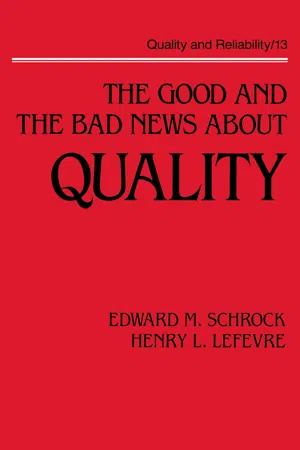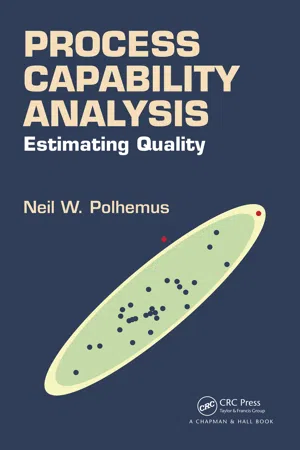Control Chart
A control chart is a statistical tool used to monitor and analyze process variations over time. It helps identify whether a process is in a state of statistical control or if there are any unusual patterns or trends that may indicate a need for corrective action. By plotting data points on a chart with control limits, it provides a visual representation of process performance.
8 Key excerpts on "Control Chart"
- eBook - ePub
- Kailash C. Kapur, Michael Pecht(Authors)
- 2014(Publication Date)
- Wiley(Publisher)
...There are four elements of process control systems: the process, information about performance, action on the process, and action on the output. The process refers to the combination of people, equipment, input materials, methods, and environment that work together to produce output. The total performance of the process depends on the way the process has been designed and built and on the way it is operated. Information about performance can be learned by studying the process output. Action on the process is future oriented, because it is taken when necessary to prevent the production of nonconforming products. Action on the output is past oriented, because it involves detecting out-of-specification output already produced. A Control Chart is a type of trend chart that displays data over time with statistically determined upper and lower control limits; it is used to determine if a process is under control. Control Charts by themselves do not correct problems. They indicate that something is wrong and requires corrective action. Assignable causes due to a change in manpower, materials, machines, or methods, or a combination of these, can cause the process to go out of control. Control Charts must be investigated in order to identify in-control and out-of-control processes and detect common causes and special causes of the out-of-control state. A process is said to be operating in statistical control when the only source of variation are common causes. An out-of-control signal is given when a sample statistic falls beyond the control limits, or when a nonrandom pattern is detected. Process capability is determined by the total variation that comes from common causes. A process must first be brought into statistical control before its capability to meet specifications can be assessed. Process capability is a measure of conformance to customer requirements and is typically measured at key process steps...
- eBook - ePub
Factory Information Systems
Design and Implementation for Cim Management and Control
- John Gaylord(Author)
- 2020(Publication Date)
- CRC Press(Publisher)
...For the statistical process engineer, Control Charting is one of several key tools that help him in his quest: to understand the variability of a process, to decompose the variability into its components, to narrow down and focus on reducing or eliminating those most important components, then to control and constantly improve the process. Until top management understands the nature of variability, it cannot move completely into the realm of objective decision-making. Objectivity in making decisions is worth a lot to managers because it lets them take or reject risks knowingly. Without understanding variability, managers have to pay a costly insurance premium; managers take smaller risks than desired, due to uncertainty in the true level of risk. Such decisions, though perhaps not biased one way or the other, will necessarily be sometimes capricious. Managers will occasionally overreact to merely random fluctuations both in accounting data—such as yields, defect rates, number produced—and in product or process measurement data, such as kiln temperature or tensile strength. Thorough training in how to make and use Control Charts is needed, for obvious reasons. It should be on at least three levels: (1) conceptual, for top managment, (2) technical, for middle-management technical people, and (3) cookbookish with a little conceptual content, for operators. An external consultant, or at least someone from another part of the company, is usually most effective in initial training, because he can bring authority and will seem to have no political axe to grind. He must be committed for the long-term, however, to see the project through to implementation. Otherwise, Control Charting will likely die off as just another management fac. The trainer should be strong in statistics. It is wise to place the conceptual emphasis of the training on understanding variability more than understanding the concepts of different Control Charts (x-bar, r, s, p, c, u, etc.)...
- eBook - ePub
- Chang W. Kang, Paul Kvam(Authors)
- 2012(Publication Date)
- Wiley(Publisher)
...CHAPTER 5 SHEWHART Control ChartS In Chapter 1, we mentioned that after completing the lessons in this book, you will have at your disposal a tool box full of tools and techniques to help with quality improvement. The Control Chart ranks first among these tools, which also include Pareto charts, flow charts, histograms, cause-and-effect diagrams and other visual aids. Control Charts are used to measure and understand the variability of a process. By reducing this variability, we achieve quality improvement. If the observed process variability can be traced to an assignable cause, our goal is to identify and remove that cause as soon as possible. In this chapter, we are going to explain how to interpret the process this way by using Control Charts. 5.1 THE CONCEPT OF A Control Chart Figure 5.1 illustrates a simple process with natural variation. As the timeline goes from lower left to upper right, process measurements are made at six time points, and the timeline itself represents a target value for the process. At each one of these time points, four samples of the process output are measured, so a total of 24 measurements are taken from start to finish. The bell-shaped curves represent the (normal) distribution of the data and the apparent variability within each cluster of four measurements. Notice that the curves have approximately the same shape and spread, indicating that the variance within each group of four clusters is about the same. Also note that the location of the middle of the bell curve changes at different time points; the mean value of the first cluster appears close to the target line, but second cluster less so. Figure 5.1 Variation in a process where 4 samples are drawn at each of 6 time measurements. This is the basis for a Control Chart, which is used to monitor variability in a process and identify the assignable cause if it exists somewhere in the process...
- eBook - ePub
- Edward M. Schrock(Author)
- 2020(Publication Date)
- CRC Press(Publisher)
...24 Interpreting Control Charts Process Control Charts are popular tools for monitoring and controlling quality. They reassure you when things are going well and they warn you when things are turning sour. With some companies, they also help production operators communicate with management. In order to make them more mysterious, some quality organizations refer to these charts as X-bar and R charts. X-bar or X are statistical abbreviations for average; the charts use averages. R is the statistical abbreviation for range; the charts use ranges. The conventional symbols for average range are either R-bar or R. The charts we discuss are also called Shewhart charts after the man who invented them. Other types of process Control Charts exist but they are not covered in this book. Figure 24.1 shows a Control Chart with a “happy days” pattern; the process is in control. Figure 24.1 Control Chart for a process that is in control (happy days pattern). Each point on the upper chart is the average of a number of measurements; in this instance, the number is five. Why five? There is nothing magic about the number five. We could use three or four or even six. It is easier, however, to calculate the average of five measurements. Ten numbers might be even simpler but it takes longer to accumulate ten observations. Specification limits should not be shown on the charts; they cause too much confusion. Specifications usually refer to individual parts, not group averages. Control limits are shown on the chart to identify warning boundaries. The upper control limit is three standard deviations above the mean. The lower control limit is three standard deviations below the mean. Does the range between the control limits sound like the process capability? It should, but there are two differences. The process capability is based on individual measurements; the control limits are based on averages...
- eBook - ePub
Process Capability Analysis
Estimating Quality
- Neil W. Polhemus(Author)
- 2017(Publication Date)
- Chapman and Hall/CRC(Publisher)
...On such a chart, the control limits are placed far enough inside the specification limits to insure that a signal is generated whenever the short-term process mean comes too close to the specs, but otherwise the process is allowed to vary as it pleases around the long-term process mean. 9.1 Capability Control Charts Capability Control Charts are used to monitor performance of a process after it has been deemed to be capable of meeting a set of requirements or specifications. The primary goal of such charts is to alert those in charge when a process appears to be moving away from its established levels. The charts are a type of Phase II statistical process Control Chart, commonly used to monitor processes in real time. Figure 9.1 shows an example of a capability Control Chart. It consists of the following elements: Point symbols showing the value of a capability index obtained from consecutive samples. A centerline at the target value of the index, established from previous analyses. Upper and lower control limits positioned above and below the centerline. Warning limits positioned 1/3rd and 2/3rds of the distance between the centerline and the control limits. The warning limits closest to the centerline are called the inner warning limits, while the warning limits farthest from the centerline are called the outer warning limits. Alerts are generated whenever an individual index is either below the lower control limit or above the upper control limit. If desired, one or the other of the control limits may be omitted, usually the one corresponding to better than expected quality, since the main purpose of the chart is to detect situations in which quality is worse than expected. Figure 9.1 Capability Control Chart with control and warning limits. The control limits are located at a distance from the centerline such that the probability of an estimated index falling beyond those limits when the process is operating at its expected level is small...
- eBook - ePub
- Suresh Patel(Author)
- 2017(Publication Date)
- Productivity Press(Publisher)
...The choice of a particular Control Chart depends on the nature of the process. When out-of-control conditions occur, action is required to restore stability. Control Charts represent the voice of the process. • Process capability studies: These studies provide us with the opportunity to understand how the voice of the process (i.e., control limits) compares with the voice of the customer (i.e., specifications), and help us determine whether the process average must be shifted or recentered or the variation reduced. • Process metrics: This includes a wide variety of in-process and end-of-process metrics that measure its overall efficiency and effectiveness. Examples include cycle times, takt time, take rate, work in process, backlogs, defect rates, rework rates, and scrap rates. Taken collectively, the above tools and methods help us gage the overall health of a process, and provide triggers for reevaluating a process for further improvement. Note: Take rate refers to the percentage of visitors who took interest in an action but did not actually follow through with that action. So, if you have 3000 web site visitors and 600 go to the download page, your take rate is 20%. If 200 download the article your conversion rate is 6.6%....
- eBook - ePub
- Irving W. Burr(Author)
- 2018(Publication Date)
- Routledge(Publisher)
...Now if the assignable cause behind the unusual performance was not found or, having been found, nothing has been done to remove it, then such data are still as typical of the process as any other and should be retained. In fact whenever any significant change is made in the process, all data produced before the change are no longer typical of the revised process and should be discarded. Periodically the center lines and control limits should be revised, perhaps after every 25 samples, and in any case after a process change, as soon as 20 or 25 samples under the new conditions have accumulated. In this way up-to-date, meaningful control lines are maintained. Periodically, also, comparison with specifications should be made so that when the process becomes stabilized with x ¯ ¯ ± 3 R ¯ /d 2 lying within specifications we can substitute the Control Chart for 100 per cent sorting. After a good period of production in control at satisfactory quality levels, it may well be possible to decrease inspection by lengthening the time between samples. Then any out-of-control points or undesirable trends are cause for taking more frequent samples and for investigation of the reason for the off performance. Many of the points of this and previous sections will be illustrated in the following section. 4.7. Illustrative Examples. Example 1. Weaver [ 3 ] gives an interesting example of the use of Control Charts in the steelmaking industry. The problem concerns the weights of ingots and the per cent of yield in rolling. Molten metal from open-hearth furnaces is poured into ingot molds, which are removed after a sufficient period of cooling. After being reheated, the ingots are then rolled into bars, perhaps four, each 25 ft long and 5 in.square. Each such bar might then be rolled into six billets, 2 in. square and 2.4 ft long...
- eBook - ePub
A First Course in Quality Engineering
Integrating Statistical and Management Methods of Quality, Third Edition
- K.S. Krishnamoorthi, Arunkumar Pennathur, V. Ram Krishnamoorthi(Authors)
- 2018(Publication Date)
- CRC Press(Publisher)
...It was not hard to convince the production people about the need for controlling the humidity. Then, they were advised on how to accomplish the control using the Control Charts. 8.3.6 Control Charts Control Charts were described in detail in Chapters 4 and 5 as the method for keeping track of a process variable or a product characteristic at a consistent level. These charts can be used not only to monitor a process for consistency but also for troubleshooting and root cause analysis in quality improvement projects. In Dr. Juran’s language, Control Charts can be used not only to watch for “sporadic deviations” but also to discover causes for some “chronic deviations” in processes. Thus, they can be employed as problem solving tools for process improvement. When Control Charts are used on a process—say, to monitor a process variable—it is customary to maintain an event log as a record of all those things happening in the process or its environment, such as a change of tool, material, humidity, or operator. This is done either by writing remarks on the chart, if it is maintained manually, or by writing it in the event journal, which most computer software packages provide. So, when the Control Chart shows that something has occurred making the process go out of control, the operator, or an improvement team, tries to relate the signal on the Control Chart with the happenings both in and around the process. More than likely, this will lead to the discovery of relationships between causes and effects and lead to resolution of problems. Case Study 8.3 illustrates the idea. Case Study 8.4 The behavior of humidity in the curing chamber in the case of the bond-failure problem was studied using Control Charts. Chamber humidity was recorded on a daily basis for a period of three weeks. Three readings were taken each day, and the data are shown in Table 8.2. X ¯ − and R -charts were drawn to study how the humidity changed in relation to what happened around the curing chamber...







